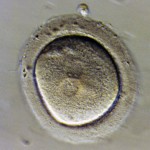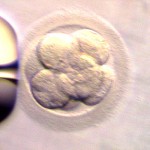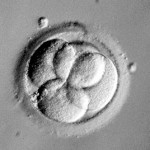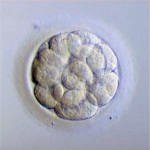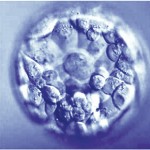Archive for the ‘embryo grading’ Category
What Impacts Embryo Donation Success Rates?

Craig R. Sweet, M.D.
Reproductive Endocrinologist

Corey Burke, B.S., C.L.S.
Laboratory Supervisor
Introduction
Asking what determines the success rates in embryo donation is an excellent question. The answer, as one might expect, is neither simple nor completely understood.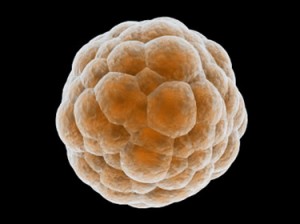
Embryologists and physicians try to choose the fewest number of healthy embryos for fresh transfers to increase success rates while minimizing multiple pregnancy rates. It is indeed a delicate balance. For example, it is well understood that in Europe, physicians transfer fewer embryos but patients also suffer significantly lower success rates than in North America. (Boostanfar R, et al. Fertil Steril 2012)
What variables do we examine to estimate probable success?
Since donated embryos are cryopreserved, the variables become even more complex compared to fresh embryos. In combining a great deal of published data and over 20 years of IVF and embryo transfer experience, we came up with what we feel are the variables which seem to influence success rates:
| Very Important! |
Preferred |
Less Optimal |
| Did the fresh cycle in which the embryos were frozen result in a pregnancy & delivery? |
Successful pregnancy and delivery |
Fresh transfer resulted in miscarriage or no pregnancy |
| Number of embryos available in a given donated set |
Four or more |
Three or fewer |
| Past implantation rates of both fresh and frozen embryo transfers |
High implantation rates |
Low implantation rates |
| Quality of the embryos frozen (link) |
High quality (Blastocyst) |
Medium quality |
| Age of the women when the eggs were provided to create embryos |
Less than 35 years old |
35 years of age or older |
| Overall health of the embryo recipient (link) |
Healthy |
With treated or untreated medical issues |
| Important |
Preferred |
Less Optimal |
| Stage of growth when the embryos were frozen (link) |
Day 5, blastocyst stage |
Day 3, 8-cell stage |
| Technique used to freeze/thaw or vitrify/warm the embryos (link) |
Vitrification |
Slow freeze |
| Overall frozen embryo transfer pregnancy rates for facility freezing the embryos |
30% or more |
Less than 30% |
| Overall frozen embryo transfer pregnancy rates for facility thawing the embryos (EDI) |
High at 30% or more |
Less than 30% |
| Ejaculated vs. surgically aspirated sperm used for fertilization |
Ejaculated sperm |
Surgically aspiration sperm |
| Somewhat Important |
Preferred |
Less Optimal |
| Was preimplantation genetic testing of the embryos done? |
Yes |
No |
| Age of the male producing the sperm |
Less than 40 years old |
More than 40 years old |
| Past successful deliveries with other embryos from donating facility |
Yes, with past deliveries |
Miscarriage, reduced survival of embryos or failed implantation |
| Probably Unimportant |
Preferred? |
Less Optimal? |
| Cryopreservation duration |
Less than 10 years? |
More than 10 years? |
The above variables influence EDI’s decision to both accept embryos from other facilities as well as determine how many donated embryos should be thawed/warmed to achieve a successful delivery.
The importance of the embryo recipient’s health should not be underestimated
In a previous blog, we described how important it was for our embryo recipients to be healthy. (link) Inadequately treated health problems, harmful medications, recreational drug use as well as smoking and weight concerns all play a potential role affecting success rates. It is clear that success depends on both the quality of the donated embryos and the overall health of the recipient.
Are all donating IVF facilities the same?
We understand that not all IVF facilities have the same success rates. Some facilities will have provided EDI 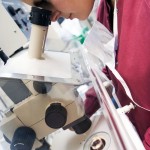 donated embryos with consistently high implantation rates while others may provide embryos of consistently lessor quality. EDI examines a facility’s past fresh and frozen embryo transfer pregnancy rates as well as its past history of providing EDI with donated embryos. It does, however, take a fair amount of time to seemingly identify a trend but we endeavor to examine all the variables we can. Our contact management database system was recently upgraded to track these variables more consistently.
donated embryos with consistently high implantation rates while others may provide embryos of consistently lessor quality. EDI examines a facility’s past fresh and frozen embryo transfer pregnancy rates as well as its past history of providing EDI with donated embryos. It does, however, take a fair amount of time to seemingly identify a trend but we endeavor to examine all the variables we can. Our contact management database system was recently upgraded to track these variables more consistently.
Do your embryos make the grade?
Understanding that all of the above variables are quite complex, we endeavored to find a simple way to convert the data into something patients could more easily understand. Since nearly all patients understand the basic A, B & C grades we used to receive in school, we modeled our grading of the embryos around these letter grades.
We created a mathematical model to assess a number of the above variables, converting the final analysis to A+, A, A-, B+, B and B- letter grades. Interestingly, we found the model really did help to predict delivery rates and continue to use it to this day to grade individual embryos as well as entire sets of donated embryos.
What information do we gain on the day of thaw and embryo transfer?
Most frequently, the embryos are thawed just hours before transfer. At times, we may thaw them days prior if, for example, they were frozen early in their development and we want to grow them further before deciding how many to transfer. Therefore, the following last set of variables will also influence success rates:
| Important |
Preferred |
Less Optimal |
| Survival rates of thawed embryos |
100% |
Less than 100% |
| Overall appearance of the thawed embryos |
Healthy, expanding and growing |
Evidence of cellular damage |
If 100% of the embryos, perhaps three out of three, survive the thaw and look healthy, we feel this is a good sign. If only 50% survive, for example perhaps only two of four, then we are concerned that the overall implantation rates will be reduced and that we might need to find more embryos to transfer just to get to the “finish line” of pregnancy and delivery. Ultimately, we want at least two high-quality embryos or up to four less certain quality embryos placed on the day of transfer.
What are the national success frozen embryo transfer delivery rates?
 In 2009, the CDC reported that there were 26,069 frozen embryo transfers performed in the U.S. with an average delivery rate of 31% per embryo transfer procedure. In addition, there were 6,074 frozen embryo transfers using embryos created from donated eggs (i.e., younger women) with slightly higher delivery rates of 34%. Please recall that donated embryos generally come from the very same types of patients listed in these success rates.
In 2009, the CDC reported that there were 26,069 frozen embryo transfers performed in the U.S. with an average delivery rate of 31% per embryo transfer procedure. In addition, there were 6,074 frozen embryo transfers using embryos created from donated eggs (i.e., younger women) with slightly higher delivery rates of 34%. Please recall that donated embryos generally come from the very same types of patients listed in these success rates.
What are EDI’s success rates?
We do our best to screen the embryos, carefully trying to choose the embryos most likely to implant. We estimate delivery rates with donated embryos to range from 27 – 42%, depending on the many variables listed in this blog, with a multiple pregnancy rates of 20-25%. We wish the success rates were higher, but please understand that frozen/thawed embryos implant and grow less frequently than fresh embryos and these percentages are entirely consistent with the frozen embryo transfer success rates described in 2009, which ranged from 31-34%.
Even with the slightly lower delivery rates compared to fresh embryo transfers, embryo donation remains one of the best and most cost-effective options for patients who cannot otherwise afford egg donation or qualify for adoption. Embryo donation still allows a woman to experience pregnancy and delivery while bonding, nurturing and protecting the ongoing gestation.
Summary
There are many variables that go into determining the potential success rates for a given set of donated embryos. First, we attempt to examine these variables carefully in deciding if EDI will accept the donated embryos. Second, we use this same information to determine how many embryos we should thaw/warm and eventually transfer. The process remains a bit of an ART (pun intended) since the complete understanding of how all of these variables influence each other and the ultimate success rates are yet to be fully known.
References
“Annual ART Success Rates.” Centers for Disease Control and Prevention. Division of Reproductive Health, 19 Apr. 2012. Web. 24 Apr. 2012. <http://www.cdc.gov/art/ARTReports.htm>.
Boostanfar R, Mannaerts B, Pang S, Fernandez-Sanchez M, Witjes H, Devroey P; Engage Investigators. A comparison of live birth rates and cumulative ongoing pregnancy rates between Europe and North America after ovarian stimulation with corifollitropin alfa or recombinant follicle-stimulating hormone. Fertil Steril. 2012 Mar 27.
Do These Donated Embryos Make the Grade?
Embryo Grading Made Easy For Embryo Donors and Embryo Recipients
Part 1 of a 3 part mini-series by Corey Burke, B.S., C.L.S. & Laboratory Supervisor and Reproductive Endocrinologist Craig R. Sweet, M.D.
Embryo grading is an important factor for both donors and recipients. Potential embryo donors want to know if we will accept their embryos for donation since part of our decision is based on the grade of their embryos. Likewise, potential embryo recipients want to know how likely the donated embryos are to survive thawing and if they are of good enough quality to build their family. Part of our estimation of success depends on the grade of the embryos.
We wish this process could be easier since there is no standardized system used in all embryology laboratories to grade embryos. Furthermore, the grading of embryos is somewhat subjective so one embryologist may grade an embryo
somewhat differently than a colleague.
Embryo grading is an imperfect process; poorly graded embryos may occasionally result in ongoing pregnancies and beautiful looking embryos may not implant and grow. Poorer graded embryos will not necessarily result in an abnormal child; they simply seem to implant and grow less frequently.
So, the appearance and grading of an embryo is an imperfect estimate of the quality of the embryo as well as the embryo’s true potential. It is, however, the best way we have to visually estimate the implantation and live birth rate of a given embryo. We will now examine one of the more common methods used to grade embryos.
When are embryos graded and cryopreserved?
Embryos are usually graded and frozen at three specific stages with “Day 0” being the day of retrieval and fertilization:
| Age of Embryos | Day 1 | Day 3 | Day 5-6 |
| Common terminology | 2PN (pronuclear stage)
2 cell stage |
Embryos are 6-10 cells | Morula &
Blastocysts |
| Grading importance | Grading not available | Grading relatively important | Grading very important |
| How often these are sent to EDI? | Rarely sent | 40% of EDI embryos | 60% of embryos |
Embryos cryopreserved immediately after fertilization are confirmed early on Day 1 (the 2PN (pronuclear stage), but aren’t advanced enough to be consistently graded. Freezing embryos on Day 1 is quite infrequent unless we are certain there will not be an embryo transfer. Accordingly, these embryos are rarely sent to EDI for embryo donation.
Grading Day 3 Embryos
Day 3 embryos are graded on cell number, the amount of cellular fragmentation and the symmetry of the embryo.
Cell Number
Most Day 3 embryos will be comprised of 6-10 cells called blastomeres. Embryos with too few blastomeres may not be healthy, so we prefer at least 7-8 at this stage. Embryos with fewer cells may not be healthy growing very slowly or may have stopped growing entirely commonly called “cell block”.
Fragmentation
Fragments may be found in many of the embryos, which are “bits” of cells that break off from a blastomere. We prefer as little fragmentation as possible. Fragmentation is estimated as the percentage of fragmentation volume compared to the total embryo volume and is converted to a letter grade in the following way:
- 0 % = A
- 1-10% = B
- 11-25% = C
- >25% = D
A large amount of fragmentation may be caused by death of one or more of the blastomeres. The higher the fragmentation, the lower the quality of the embryo & letter grade and the less likely that the embryos will survive thawing. Embryos with high fragmentation rates implant less frequently when transferred fresh or when thawed.
Symmetry
Symmetry of the embryo refers to the shape of the individual blastomeres and the overall shape of the embryo. The blastomeres should all be very similar in size and generally round in shape. The scale used to grade symmetry is
- Perfect = A
- Moderately asymmetric = B
- Severely asymmetric = C
Severe blastomere asymmetry (i.e., large and small blastomeres in the same embryo) reflect nuclear/chromosomal and cytoplasmic problems suggesting the embryo is less healthy than desired. There is supporting evidence that blastomere symmetry is important and reflects overall health of the embryo. Interestingly, the overall symmetry of the embryo (round vs. oval) is of uncertain importance with some very “funny looking” embryos resulting in beautiful and healthy children.
Putting it All Together for Day 3 Embryos
For Day 3 embryos, the order of grading is the “number of cells (#c),” “fragmentation grade” and “symmetry grade”. For example:
- 7cAA = 7 cells with no significant fragmentation and perfect symmetry
- 8cBA = 8 cells with 1-10% fragmentation and perfect symmetry
- 6cBB = 6 cells with 1-10% fragmentation and moderate asymmetry.
Grading Day 5 Embryos
More advanced embryos are graded and potentially frozen on Day 5 or Day 6. These are generally described as morula or blastocysts.
Day 5 Morula Embryos
Morula embryos are difficult to grade as the cells combine, forming essentially a ball of cells that can’t really be categorized in any way other than descriptive terms:
- Morula (early)
- Compacting morula (more advanced)
While some facilities only occasionally cryopreserve Day 5 morula embryos, it is thought that the survival and implantation rates of these embryos may be slightly reduced but they are still quite reasonable, suggesting that they should not be discarded. Day 6 morulas are probably delayed in growth or may have stopped growing, may not be viable and are infrequently cryopreserved.
In order to balance the possible reduced implantation rates, it is common that more morula embryos are thawed and transferred in order to achieve success.
Day 5 Blastocyst Embryos
Day 5 blastocyst embryos are the most advanced embryos we see in IVF. These embryos are formed within 24 hour of actual implantation. Trying to grow embryos beyond this point is
technically difficult, as the embryos usually don’t survive. In addition, the window of time for implantation seemingly closes beyond Day 5 or early day 6. For example, transfer on Day 7 will rarely result in implantation. So, it simply makes more sense to transfer and/or freeze blastocysts rather than trying to grow them any further.
Along with descriptive measures, more objective grading is attempted through evaluation of the cellular expansion, the inner cell mass (which eventually becomes the fetus) and the quality of the outer cell mass called the trophectoderm (which eventually forms the membranes and placenta).
Expansion
As the embryo advances in growth, a cavity called the blastocoel fills with fluid. As the cells continue to divide and the fluid collects, the embryo expands and eventually escapes its outer covering called the zona pellucida. The blastomeres continue to group together wherein the individual cell cannot be counted. As the Day 5 embryo expands, differentiates and escapes the outer zona pellucida, the grade increases numerically from 1-5.
| Grade | Description | Physiology |
| 1 | Early Blastocyst | Starting to form a fluid-filled space in the middle (Blastocoel). Grading the embryo is difficult here. |
| 2 | Full Blastocyst | Blastocoel forms and inner cell mass is now distinguishable. Grading can be done from this point forward. |
| 3 | Expanded Blastocyst | Blastocyst is starting to expand in size thinning the outer covering, the zona pellucida |
| 4 | Hatching Blastocyst | Blastocyst is starting to hatch out of the zona pellucida. |
| 5 | Hatched Blastocyst | Blastocyst is fully hatched and now ready for implantation into the uterine wall. |
Inner Cell Mass (ICM)
As the blastomeres compact to form the inner cell mass (ICM), this early fetal tissue is graded on a A-D scale:
| ICM Grade | Description |
| A | ICM with total compaction |
| B | ICM still compacting |
| C | Reduced ICM |
| D | Poor with dying cells |
Trophectoderm (TE)
The outer cells of the trophectoderm (TE) also reflect the overall health of the embryo and are graded in an A-D scale.
| TE Grade | Description |
| A | Numerous cells forming cohesive layer |
| B | Few but healthy large cells forming a loose epithelium |
| C | Few cells present often with asymmetric distribution |
| D | Poor with degenerating/dying cells |
Putting it All Together for Day 5 Embryos
For Day 5 embryos, the order of grading is “expansion,” “inner cell mass” and “trophectoderm.” For example:
- 1 = Early blastocyst is unable to be easily graded with respect to ICM or TE as these haven’t separated well enough yet.
- 2BB = Blastocyst with partial ICM compaction with loose, large trophectoderm cells
- 3AB = Expanding blastocyst with total compaction of ICM and with loose, large trophectoderm cells
- 4AA = Hatching blastocyst with excellent ICM & trophectoderm cell layers
- 5AA = Fully hatched blastocyst with excellent ICM & trophectoderm cell layers
Day 5 embryos that are graded 4AA and 5AA are some of our favorite embryos.
Summary Comments
Embryology laboratories strive to grow the healthiest embryos they can. Over time, they have adapted different grading techniques so the laboratories can communicate the quality of the embryos to physicians, patients and each other. Not all beautiful embryos will implant or produce a healthy child but they seem to do so more often than others. Not all poorly developing embryos will fail to implant and produce a healthy child but most do not result in live offspring.
At EDI, we try to only accept embryos that are likely to implant so embryos with less than a B rating for any category are infrequently accepted. This is done to assure our recipients that all of the donated embryos we offer are of the highest quality and provided the greatest chance for a successful pregnancy.
This is only one piece of the puzzle as many other factors influence the likelihood for success. Dr. Sweet will cover this topic in the separate blog within the next couple of months.
Also stay tuned to the upcoming blogs regarding how embryos are frozen and thawed and what techniques seem to work the best.
While embryo grading is not a perfect system, we use it to try to predict the overall quality of the embryos and their potential to survive thaw, grow and build a recipient’s family.
Corey Burke. B.S., C.L.S.
Laboratory Supervisor
CBurke@EmbryoDonation.com
Craig R. Sweet, M.D.
Reproductive Endocrinologist
Info@EmbryoDonation.com
References
Racowsky C, Vernon M, Mayer J, Ball GD, Behr B, Pomeroy KO, Wininger D, Gibbons W, Conaghan J, Stern JE. Standardization of grading embryo morphology. Fertil Steril. 2010 Aug;94(3):1152-3.
